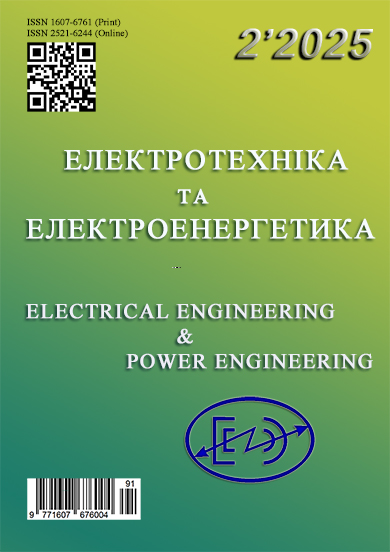Research of thermal processes of an IGBT module-based inverter
DOI:
https://doi.org/10.15588/1607-6761-2025-2-3Keywords:
thermal processes, inverter, IGBT module, frequency converterAbstract
Purpose. Study of thermal processes of an inverter based on an IGBT module for used in a frequency converter to control the operation of an asynchronous motor.
Methodology. Analytical and computational methods to analyse thermal processes of an inverter based on an IGBT module.
Findings. The study of thermal processes of the SKM200GB12T4 inverter based on the IGBT module was performed using the SemiSel program. A mathematical model of the cooling process of the SKM200GB12T4 inverter was developed. The dependence of the dynamic thermal impedance Zth(s-a) on time, which is described by an exponential function, was obtained. The value of the time constant for this dependence, which characterizes the rate of change in the cooler temperature, i.e. the quality of its operation, has been calculated. The thermal time constant τ = 1.44 s indicates the time required to reach a temperature difference of approximately 63% of its stationary value. This low value reflects the effective cooling due to the high air flow velocity (7 m/s) and air flow rate (426.43 m³/h), which is critically important for maintaining the IGBT junction temperature below 175 °C during overload.
The values of the inverter temperature maxima during overload were obtained. For an overload of 10.94 seconds, the maximum temperature for IGBT transistors is 120.85 °C, and for diodes – 123.4 °C. The case temperature Tc = 71.21 °C and the radiator temperature Ts = 63.56 °C remain the same for transistors and diodes and do not exceed the maximum operating temperature of the module due to the stability of the cooling system. However, overheating can increase with prolonged loading, resulting in the degradation of semiconductor devices.
The temperature and power variation processes at nominal load and in overload mode for one period have been studied using the SemiSel program. The temperature change graphs reflect the stability of the temperature at various points, such as the transitions of IGBT transistors and reverse diodes, due to effective thermal control. The power graph indicates cyclical changes in losses, with peaks in the phases where current and voltage are maximum. These data confirm the suitability of the module for use in control circuits.
Originality. Based on the graphical analysis of the kinetic dependencies of temperature and inverter power, a mathematical model of the cooling process of the SKM200GB12T4 inverter was developed, that describes the dependence of the dynamic thermal impedance Zth(s-a) on time. The thermal time constant for this dependence, which characterises the rate of change of the cooler temperature, was calculated.
Practical value. The results of the study of the thermal characteristics of the SKM200GB12T4 inverter can be used to optimize the operating modes of the frequency converter for controlling the operation of an asynchronous motor.
References
Zagirnjak, M. V., Koren'kova, T. V., Kalinov, A. P., Gladyr, A. I., Koval'chuk, V. G. (2017). Suchasni peretvorjuvachi chastoty v systemah elektropryvo-da : navch. posibnyk. Harkiv: Vydavnyctvo «Toch-ka», 206. ISBN 978-617-7470-78-5.
Pressman, A. I. (1999). Switching Power Supply De-sign. New York: McGraw-Hill, Inc., 677.
Shishkin I. R., Lushchin S. P. (2023). Controlling electrical circuit of electric motor on IGBT transis-tors. Electrical Engineering and Power Engineering, 1, 30-35. DOI: https://doi.org/10.15588/1607-6761-2023-1-3
www.semikron-danfoss.com
https://assets.danfoss.com/documents/latest/444048/AB501651003501en-000201.pdf
Ostrenko V.S., Kulinich Je.V. (2012). Vyznachennja krashhogo typu IGBT modulja dlja zastosuvannja v peretvorjuvachi chastoty. Naukovyj visnyk NGU. Elektrotehnichni kompleksy i systemy, 5, 80-85.
Mohammad Shahjalala et al. Thermal Analysis of Si-IGBT based Power Electronic Modules in 50kW Traction Inverter Application. Preprint. https://ssrn.com/abstract=4091251.
Chen, Xi & Huang, Shenghua & Li, Bingzhang & Xiang, Yangxiao. (2018). Losses and thermal cal-culation scheme of IGBT and FWD and its applica-tion in PWM inverters for electric engineering maintenance rolling stock: LOSSES AND THER-MAL CALCULATION SCHEME OF IGBT AND FWD. IEEJ Transactions on Electrical and Electron-ic Engineering. 13. 10.1002/tee.22744. DOI:10.1002/tee.22744
https://www.edn.com/using-igbt-thermal-calculations-to-optimize-power-designs/
Xinyu Fan et al. (2020). IGBT Heat Dissipation De-sign and Optimization. J. Phys.: Conf. Ser. 1635 012024. doi:10.1088/1742-6596/1635/1/012024
Bahman, Amir & Ma, Ke & Blaabjerg, F. (2014). Thermal Impedance Model of High Power IGBT Modules Considering Heat Coupling Effects. Pro-ceedings - 2014 International Power Electronics and Application Conference and Exposition, IEEE PEAC 2014. 10.1109/PEAC.2014.7038066. DOI:10.1109/PEAC.2014.7038066
C. Qian et al., (2018).Thermal Management on IGBT Power Electronic Devices and Modules, in IEEE Access, 6, 12868-12884. doi: 10.1109/ACCESS.2018.2793300.
Cova, Paolo & Ciappa, Mauro & Franceschini, Giovanni & Malberti, P. & Fantini, Fausto. (1997). Thermal characterization of IGBT power modules. Microelectronics Reliability. 37. 1731-1734. 10.1016/S0026-2714(97)00150-9. DOI:10.1016/S0026-2714(97)00150-9
Tang, C., Thiringer, T. (2019). Thermal modelling of a mutlichip IGBT power module. 2019 21st Euro-pean Conference on Power Electronics and Appli-cations, EPE 2019 ECCE Europe. http://dx.doi.org/10.23919/EPE.2019.8914769
Younes Shabany. Heat transfer. Thermal Meneg-ment of Electronics. (2011), CRC Press, 524 p. ISBN 9781439814673.
Lienhard, J.H. IV and Lienhard, J.H.V. (2019). A Heat Transfer Textbook. 5th Edition. Dover Pub., 784. ISBN-13: 978-0486837352.
Downloads
Published
How to Cite
Issue
Section
License
Copyright (c) 2025 S.P. Lushchin, D.P. Paxar

This work is licensed under a Creative Commons Attribution-ShareAlike 4.0 International License.
Creative Commons Licensing Notifications in the Copyright Notices
Authors who publish with this journal agree to the following terms:
Authors retain copyright and grant the journal right of first publication with the work simultaneously licensed under aCreative Commons Attribution License that allows others to share the work with an acknowledgement of the work's authorship and initial publication in this journal.
Authors are able to enter into separate, additional contractual arrangements for the non-exclusive distribution of the journal's published version of the work (e.g., post it to an institutional repository or publish it in a book), with an acknowledgement of its initial publication in this journal.
Authors are permitted and encouraged to post their work online (e.g., in institutional repositories or on their website) prior to and during the submission process, as it can lead to productive exchanges, as well as earlier and greater citation of published work.

